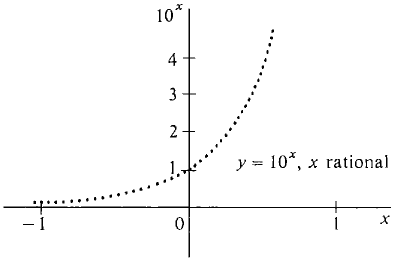| The ebook Elementary Calculus is based on material originally written by H.J. Keisler. For more information please read the copyright pages. |

|

Home  Differentiation Differentiation  Transcendental Functions Transcendental Functions  Exponential Functions Exponential Functions |
|||||||||||||||||||||||






|
|||||||||||||||||||||||
Exponential Functions
Given a positive real number b and a rational number m/n, the rational power bm/n is defined as
the positive nth root of bm. The negative power b-m/n is
As an example consider b = 10. Several values of 10m/n are shown in Table 2.5.2.
Table 2.5.2. If we plot all the rational powers 10m/n, we get a dotted line, with one value for each rational number m/n, as in Figure 2.5.6.
Figure 2.5.6 By connecting the dots with a smooth curve, we obtain a function y = 10x, where x varies over all real numbers instead of just the rationals. 10x is called the exponential function with base 10. It is positive for all x and follows the rules 10a+b = 10a · 10b, 10a·b = (10a)b.
|
|||||||||||||||||||||||
Home  Differentiation Differentiation  Transcendental Functions Transcendental Functions  Exponential Functions Exponential Functions |
|||||||||||||||||||||||
Last Update: 2006-11-25












